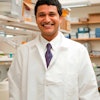As an attentive and adept middle schooler growing up in Tallahassee, Fla., Chekesha M. Liddell Watson loved nothing more than methodically maneuvering 3,000-piece puzzles into place. While she was fascinated by how the puzzle pieces made up the whole, her parents Amos, a college administrator, and Patricia, a social worker, eyed the “big picture.” They quickly noticed their daughter’s “good comprehension of spatial relationships,” recalls Watson, now an associate professor of Materials Science and Engineering at Cornell University.
Her parents were the first to tell her to consider a career in engineering, Watson says. In 2007, nearly two decades later, the White House also took notice. The materials engineer and 20 others were honored with the Presidential Early Career Awards for Scientists and Engineers. The award is the nation’s highest honor for professionals at the outset of their independent scientific research careers.
In Watson’s case, the making of an award-winning scholar and engineer took root in enrichment and with robots.
From about the age of 8, Watson’s parents filled her summers with math and science enrichment workshops. By her junior year in high school, Watson was building robots at a Massachusetts Institute for Technology summer camp with other budding minority scientists. By the time Watson entered Spelman College, where she majored in chemistry, she had already co-authored a paper with and worked alongside one of the Kennedy Space Center’s top female scientists. She continued her relationship with NASA during college with a NASA Women in Science and Engineering Scholarship. Interning in NASA’s microchemical analysis laboratories helped lead Watson to nanoscience, the study of manipulating matter on an atomic and molecular scale.
“That’s really where I got excited about understanding materials at small scales and being able to solve problems with that understanding,” says Watson. “We actually investigated some space shuttle tiles, which were a very big issue at the time, in the wake of the Challenger disaster. We were detectives, discovering how engineering could mean the difference between life and death.”
Today, in her lab at Cornell, Watson remembers the massive puzzles of her childhood. This time the pieces she and her research team create and handle are chemically synthesized particles called colloids, too tiny to be seen with the naked eye.
“My central interest is in understanding the role of symmetry and crystal structure in the interaction between light and colloidal materials,” Watson says. “I’m interested in expanding understanding from the opal-type structures through a range of structures with new geometries.”
Watson’s groundbreaking investigation of colloids traces back to her dissertation work at the Georgia Institute of Technology. Rather than using the typical spherical shapes, Watson created colloids shaped like mushroom caps, snowmen, and peanuts, hypothesizing that they could be more easily processed and assembled into photonic — or light transferring — crystals. The opal, a gemstone not normally used in scientific experiments, is the example Watson uses to explain how this naturally occurring clear crystal interacts with light, making it appear to be full of color. The research has practical and industrial applications, including cloaking and invisibility devices for the U.S. military or photonic-based computer processing. While getting the process just right has proved challenging, Watson has been relentless in her pursuits, say students and colleagues.
“Chekesha is doing significant fundamental research in the area of colloidal crystals, which have the potential to revolutionize a number of key technologies including optics and sensing,” notes Christopher K. Ober, the Francis Bard Professor of Materials Engineering at Cornell.
Watson has another application in mind for colloids, which appear to be solutions but are actually mixtures of particles suspended in liquid. When dried, Watson compares the residue left in some of the test tubes to shimmering Mother of Pearl. When viewed under powerful electron microscopes, they resemble lavishly colorful patterns she likens to wallpaper. One day Watson hopes to capture those lovely images and transform them into art and — what else — jigsaw puzzles as a way to introduce young people to science and engineering.
Regardless where her research takes her, Watson says her place will remain in the classroom and in the lab.
Title: Associate professor of materials science and engineering, Cornell University
Education: Ph.D.: Materials Science and Engineering, Georgia Institute of Technology;
B.S.: Materials Engineering, Georgia Institute of Technology; B.S.: Chemistry, Spelman College
Age: 34
Career Mentors: Etta Falconer and Cornelia Gillyard (Spelman College); Stuart Stock, Chris Summers, Naresh Thadhani, Ashanti Johnson (Georgia Tech); Martha Williams (NASA, Kennedy Space Center); Chris Ober, Emmanuel Giannelis, Lance Collins (Cornell University); Gilda Barabino and Christine Grant (through women and minority faculty peer mentoring programs)
Words to Live By: “Dripping hollows out stone.” Ovid. Meaning it pays to bepersistent and consistent.















